This is Bishop Robert Caldwell, celebrated missionary and scholar, who published in 1856 the "Comparative grammar of Dravidian or South Indian Languages".
Link:
archive.org/details/compar…
It has a large appendix devoted to racist theories. In this thread, I will discuss them.
Link:
archive.org/details/compar…
It has a large appendix devoted to racist theories. In this thread, I will discuss them.
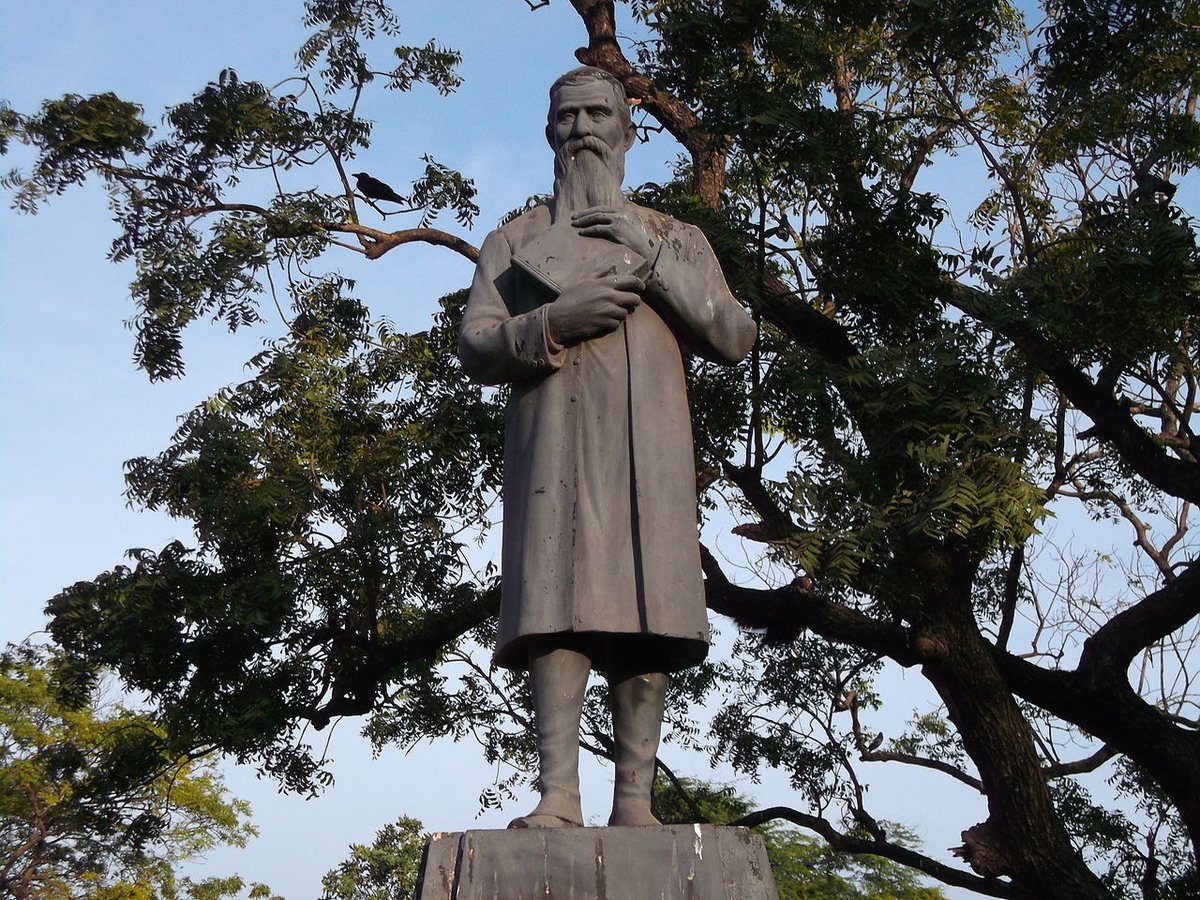
Bishop Caldwell might have long been dead, along with the British Empire of which he was a servant, but his theories about the Dravidian race are an active force in Indian politics. They are the mainstream dogma in books and academia.
But many people have not read them at all.
But many people have not read them at all.
Anybody in our age might be puzzled why a book of grammar would discuss race theories at all. In the Indian Śāstric tradition, we would ask "Kim Prayōjanam" (what is the benefit / point?).
But there is a point for all these race theories in the historical method of Dr. Caldwell.
But there is a point for all these race theories in the historical method of Dr. Caldwell.
The historical method in philology, or comparative analysis of languages, is based on the Biblical framework of history. All the races of humans were supposed to have descended from progeny of Noah, after the great flood. The task of these scholars is to map the descent of races.
So the work on grammar is a sideshow. The mainshow or "Prayōjanam" is the Biblical historical descent of races. Similar to the vocabulary or morphology of languages, the racial characteristics of facial features etc. are given as arguments towards a theory of Biblical descent.
Bishop Caldwell had a racial theory about the Dravidians, that they were descended from the so called "Scythian" race which was roaming in Central Asian plains before it came to India.
Naturally, Central Asia is closer to the Biblical homeland where the Biblical history unfolds.
Naturally, Central Asia is closer to the Biblical homeland where the Biblical history unfolds.
This "Scythian" race was identified to be separate from the race of the "Indo-Europeans" (or the "Aryans"). The contribution of Bishop Caldwell to this race theory is that South Indian people, who are generally darker skinned, somehow evolved from a "Mongolian" type.
In his book on the grammar of Dravidian languages, Caldwell devotes about 50 pages to the discussion of races. But this racist methodology is present throughout his linguistic work, selective evidence of word etymologies and so on. Now without further ado, let us delve into this.
Caldwell argues if the out-castes of South India (Pareiyas etc.) were originally Dravidians, or rather the descendants of a "ruder and darker race". He says that the second theory is not "destitute of probability". 
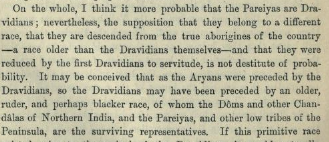
But being a "scientific" race scientist, Dr. Caldwell argues that the skin colo is not indicative of race, but rather the shape of the skull etc, which do not distinguish the Pareiyas from other communities. The dark color is due to "laboring under a sun hotter than in Egypt". 
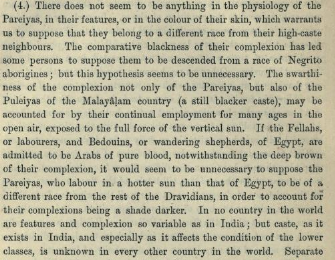
Religious practices of India are grouped into "Heliolatry" (like the Aryan paganism) and "Demonolatry" (idol worship etc. which is the work of the devil itself). Caldwell says the "demonolatry" of Dravidians seeped into the Aryan religion itself, through the worship of "Rudra". 

It appears that Christian missionaries of the 19th century believed that the religious practices of a people influenced physical appearance. Caldwell spends sometime on how the "Demonolatry" of Dravidians can occur in tandem with racial similarity to other communities of India. 
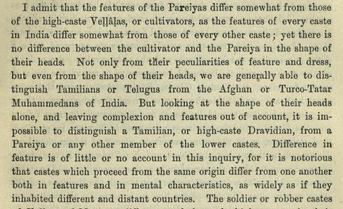
In Caldwell's time, there was a theory that the Toda people of the mountains in South India descended from the Celtic Druids. So Caldwell spends some time arguing that the Toda people are the same as the other Dravidians, and owe their lighter skin to just their mountain habitat. 
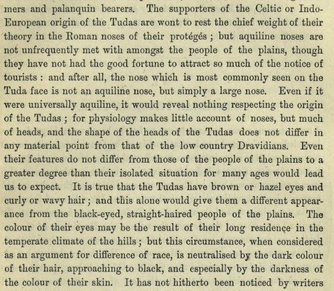
Based on the shape of head and nose, Caldwell grouped most of the South Indian tribes under the "Dravidian" race, which he identified as pretty similar to the Aryan race of the north India. But he had a problem with forest tribes like Gonds, who "seem to be Generally Mongolian". 
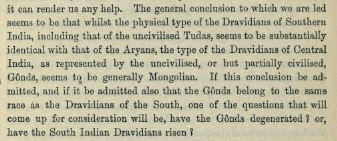
There was a distinct hierarchy of races in the 19th century "science". Europeans were obviously the best. Indians and Middle-Eastern people, who had "Aryan" features, were behind. Caldwell identified "Dravidian" as roughly the same as "Aryan". But the "Mongolian" type was worse.
According to Caldwell, these are the distinctions of the racial characteristics of the Aryan form and the Tamilian form. He quotes one Mr. Hodgson, and says that there was a "Mongolian stamp" impressed on all the aborigines of India. 

Caldwell also discusses a theory of one Mr. de Quatrefages, that the aborigines of India are not "Mongolian race" but rather the "Negroid race". Apparently, the theory was that Dravidians arose from a mixture of "black and yellow races". Caldwell was not happy with this theory. 
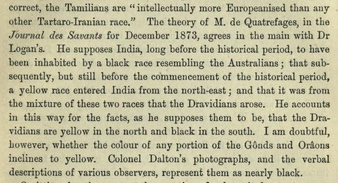
Caldwell says "Dravidian race" is similar to the Aryan or its sibling European race. He charmingly compares "the heads of the Tamil or Telugu pleaders in any Zillah court with that of the presiding English judge". They are the same, except for "signs of timidity and subtilty". 

Caldwell also discusses the theory of Colonel Dalton, in his "Descriptive Ethnology of Bengal", that the Gonds are not of the Mongolian type, but of the Negro type.
"They often have short, crisp, curly hair", but not exactly the same as the "woolly covering of a Negro's head".
"They often have short, crisp, curly hair", but not exactly the same as the "woolly covering of a Negro's head".
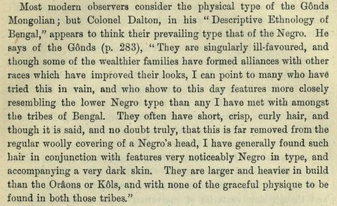
Caldwell's theory is that the skin color is not very relevant to the racial history of India. He gives the example of Portuguese descendants in Goa "who are now blacker than the Hindus themselves". He also ranks the various Brahman communities of India in their skin color. 
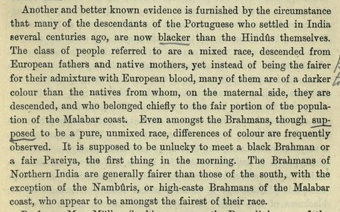
Caldwell now gets to the crux of his problem. The aborigines of India are not "Negrito" but "Mongolian". So how come they have lost "the flat head, the squat nose, and the thick lips, which are the characteristics of their race"? And "blackness is not a Mongolian characteristic". 
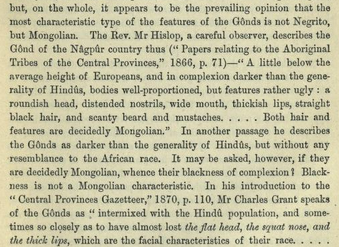
Now Caldwell makes his great contribution to the theory of "race science".
"There has been no example for a descent from the Caucasian to the Mongolian" but there could be "an ascent from the Mongolian to the Caucasian" in Dravidians, aided by a "small intermixture with Aryans"
"There has been no example for a descent from the Caucasian to the Mongolian" but there could be "an ascent from the Mongolian to the Caucasian" in Dravidians, aided by a "small intermixture with Aryans"
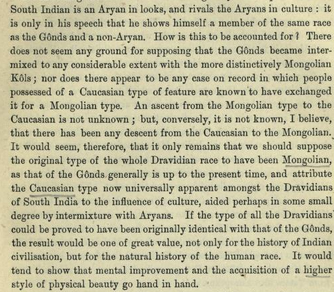
Caldwell argues that this "ascent from the Mongolian race to the Caucasian" can also be seen in the Muslim communities of India, who he says were all descended from Mongolian looking Turks, but who now are indistinguishable from their Hindu neighbors, except in minor features. 

So Caldwell's theory was that the "mass of the Dravidians" just before they "parted company from the Gonds" were "distinctively Turanians (Turks) in physical type". His book on Dravidian grammar has consequently a chapter on similarities of Dravidian and "Scythian" languages. 
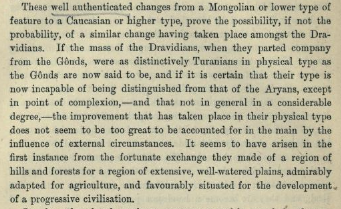
Caldwell explicitly states that this ascent of racial beauty in the Dravidians is accompanied by an improvement of the civilization, due to the practice of agriculture.
He states, "mental improvement and the acquisition of a higher style of physical beauty go hand in hand".
He states, "mental improvement and the acquisition of a higher style of physical beauty go hand in hand".
Caldwell refers to Strabo and the literature of Greeks on India, to propose a theory about how a barbarian Mongolian race (original Dravidians, or "Adi-Dravidas" according to him) colonized India. He says that the Kirātas and Bhotias (Tibetans) are of a different Mongolian type. 
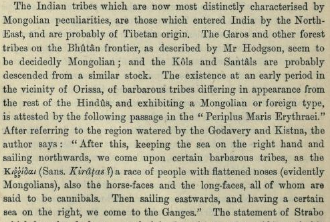
Apparently, some of these "original Dravidians" were also cannibals, as those tribes seem to have been mentioned by Strabo.
I hope that the Dravidian political advocates carefully read Dr. Caldwell's book to see what he makes out of them. 😀
I hope that the Dravidian political advocates carefully read Dr. Caldwell's book to see what he makes out of them. 😀
Caldwell refers to the work of Dr. Buchanan Hamilton (an "accurate observer") on how the Gonds and other proto Dravidians were not Negroids, may have lost their original Mongolian looks, but that it would be a mistake to attribute a descent from "Aryan princes of the lunar line". 
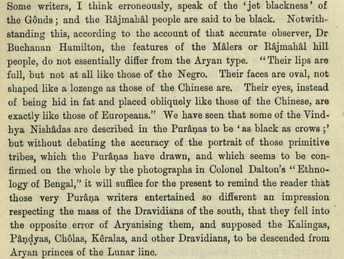
Caldwell prides himself on "his love for the Dravidian languages".
But he also says, "It is not as if the people in the South conquered by the Aryans had been a highly civilized people, with a cultivated language and a literature of their own."
But he also says, "It is not as if the people in the South conquered by the Aryans had been a highly civilized people, with a cultivated language and a literature of their own."
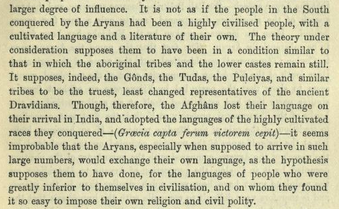
Caldwell characterizes the "Aryan" people speaking Indo-European languages with a religion of "Heliolatry: worshipping the sun, the sky, water, fire and other elements of nature personified".
He says Dravidian or "Scythian" people could be characterized by a different religion.
He says Dravidian or "Scythian" people could be characterized by a different religion.

So what is this religion of the Dravidian people? According to Bishop Caldwell, it is a "Demonolatry", or "the worship of evil spirits by the means of bloody sacrifices and frantic dances".
He says the Dravidian Demonolatry is "identical" to the Siberian Shamanical practices.
He says the Dravidian Demonolatry is "identical" to the Siberian Shamanical practices.
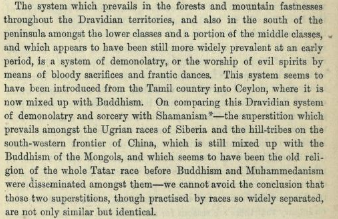
Caldwell has a very detailed description of the "Shamanite Demonolatrous Rites". Behold the imagery which would make the creators of the "Indiana Jones: Temple of Doom" proud.
So much for the love of Dr. Caldwell to the Dravidian people.
So much for the love of Dr. Caldwell to the Dravidian people.
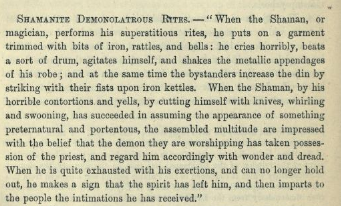
"Dr. Caldwell has given a striking account of the practice of devil-dancing among the Shannars of Tinnevelly", Caldwell proudly quotes one Colonel Yule, before describing the Demonolatry of the Dravidians, which "Hinduism has assimilated" in "Tantrika mysteries". 
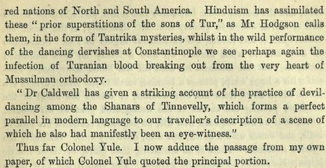
Here is Caldwell's description of "Shânâr Demonolatrous Rites". The Shanar or Nadar is a community in Tamil Nadu.
"The officiating priest is styled a devil-dancer... The object in view in donning the demon's insignia is to strike terror into the imagination of the beholders."
"The officiating priest is styled a devil-dancer... The object in view in donning the demon's insignia is to strike terror into the imagination of the beholders."
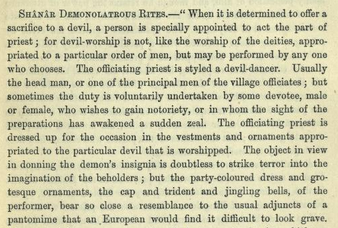
Caldwell was particularly perturbed by the "musical instruments, or rather the instruments of noise" used in the "devil dance" of the Shanar community. 
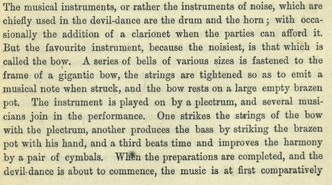
Caldwell was horrified by this Demonolatry of the Dravidians.
"There is no mistaking that glare, or those frantic leaps. He snorts, he stares, he gyrates. The demon has now taken bodily possession of him".
You get the drift. That is Caldwell's love for "Dravidian culture".
"There is no mistaking that glare, or those frantic leaps. He snorts, he stares, he gyrates. The demon has now taken bodily possession of him".
You get the drift. That is Caldwell's love for "Dravidian culture".
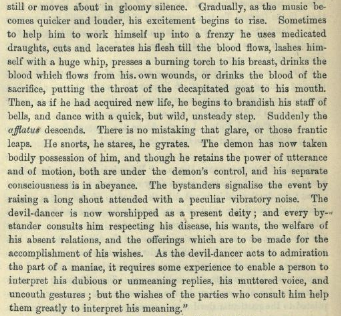
Some Dravidian tribes like Tuda are characterized by "mildness and contentedness", and avoid "much of the demonolatrous habit of other members of that Dravidian race to which they belong".
They have come to them "from the instrumentality of the Aryans, from Brahmanical sources".
They have come to them "from the instrumentality of the Aryans, from Brahmanical sources".
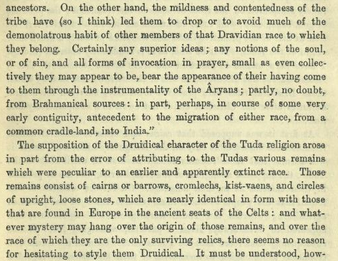
Can somebody please explain to me how this first class racist, Bishop Robert Caldwell, is held as a hero by the Tamilian Dravidian parties? Why does he have a statue in Chennai that is garlanded regularly by those politicians? Do they have any sense of shame, or even commonsense?
This is just complete racist rubbish. It just beats me that this nonsense is taken so seriously, and so reverentially in today's era.
We have this opinion of American Indologist Dr. Trautmann, that Caldwell's Dravidian grammar was "magnificent". Really?
frontline.thehindu.com/other/article3…
We have this opinion of American Indologist Dr. Trautmann, that Caldwell's Dravidian grammar was "magnificent". Really?
frontline.thehindu.com/other/article3…
How can Bishop Caldwell's grammar be considered with any amount of seriousness, when it is infested from head to toe, with a degenerate racist outlook? The whole point about establishing a kinship of Dravidians to "Scythian languages" is to argue about this "demonolatry".
What Caldwell did, with his "comparative grammar", was simply selective cherrypicking. Other than Tamil, he didn't know any other Dravidian language with any competence. His "philology" is as much of a bullshit as his race theory.
Why is this Dravidian thing still a thing !?
Why is this Dravidian thing still a thing !?
I will end my thread here. But this stupid Dravidian grammar needs to be eviscerated. It is mind-boggling that such racist bullshit is actually championed by the "Dravidian" parties themselves.
How can anybody make any sense of this weird type of pride!? (end of thread)
How can anybody make any sense of this weird type of pride!? (end of thread)
• • •
Missing some Tweet in this thread? You can try to
force a refresh




